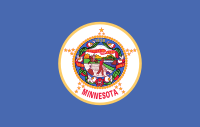The Minnesota Portal Minnesota ( /ˌmɪnəˈsoʊtə/ ⓘ MIN-ə-SOH-tə) is a state in the Upper Midwestern region of the United States. It is the 12th largest U.S. state in area and the 22nd most populous, with over 5.75 million residents. Minnesota is known as the "Land of 10,000 Lakes" for having more than 14,000 bodies of fresh water covering at least ten acres each; roughly a third of the state is forested; much of the remainder is prairie and farmland. More than 60% of Minnesotans (about 3.7 million) live in the Minneapolis–Saint Paul metropolitan area, known as the "Twin Cities", the state's main political, economic, and cultural hub and the 16th-largest metropolitan area in the U.S. Other minor metropolitan and micropolitan statistical areas include Duluth, Mankato, Moorhead, Rochester, and St. Cloud. Minnesota, which gets its name from the Dakota language, has been inhabited by various Indigenous peoples since the Woodland period of the 11th century BCE. Between roughly 200 and 500 CE, two areas of the indigenous Hopewell tradition emerged: the Laurel complex in the north, and Trempealeau Hopewell in the Mississippi River Valley in the south. The Upper Mississippian culture, consisting of the Oneota people and other Siouan speakers, emerged around 1000 CE and lasted through the arrival of Europeans in the 17th century. French explorers and missionaries were the earliest Europeans to enter the region, encountering the Dakota, Ojibwe, and various Anishinaabe tribes. Much of what is now Minnesota formed part of the vast French holding of Louisiana, which the United States purchased in 1803. After several territorial reorganizations, the Minnesota Territory was admitted to the Union as the 32nd state in 1858. Minnesota's official motto, L'Étoile du Nord ("The Star of the North") is the only state motto in French; this phrase was adopted shortly after statehood and reflects both the state's early French explorers and its position as the northernmost state in the contiguous U.S. As part of the American frontier, Minnesota attracted settlers and homesteaders from across the country. Its growth was initially based on timber, agriculture, and railroad construction. Into the early 20th century, European immigrants arrived in significant numbers, particularly from Scandinavia, Germany, and Central Europe; many were linked to the failed revolutions of 1848, which partly influenced the state's development as a center of labor and social activism. Minnesota's rapid industrialization and urbanization precipitated major social, economic, and political changes in the late 19th and early 20th centuries; the state was at the forefront of labor rights, women's suffrage, and political reform. Consequently, Minnesota is unique among Midwestern states in being a relative stronghold of the Democratic Party, having voted for every Democratic presidential nominee since 1976, longer than any other U.S. state. ( Full article...) Entries here consist of
Good and
Featured articles, which meet a core set of high editorial standards.
Pearson's Candy Company is an American chocolate and confectionery manufacturer headquartered in Saint Paul, Minnesota. Founded as a confectionery distribution firm in 1909, the company began to manufacture its own products in 1912. Originally a family-owned company, Pearson's experienced changes in ownership, acquisitions and product alterations in the 1960s, 1970s and 1980s, before its most recent sale in November 2018 to Spell Capital, a Minneapolis private equity firm. Pearson's products are produced on five production lines in the company's Saint Paul plant. The company sells its Mint Patties and Salted Nut Roll nationally and its Nut Goodie and Bun Bars products in several Midwestern states. As of 2018, Pearson's was estimated to be the 42nd largest confectionery company in North America by revenue. ( Full article...)Selected article -The music of Minnesota began with the native rhythms and songs of Indigenous peoples, the first inhabitants of the lands which later became the U.S. state of Minnesota. Métis fur-trading voyageurs introduced the chansons of their French ancestors in the late eighteenth century. As the territory was opened up to white settlement in the 19th century, each group of immigrants brought with them the folk music of their European homelands. Celtic, German, Scandinavian, and Central and Eastern European song and dance remain part of the vernacular music of the state today. Ethnic music has influenced and developed into modern folk music, and American musical genres such as gospel music, blues and jazz also are part of the state's musical fabric. Musicians, such as the Andrews Sisters and Bob Dylan, often started in Minnesota but left the state for the cultural capitals of the east and west coasts, but in recent years the development of an active music industry in Minneapolis has encouraged local talent to produce and record at home. The city's most influential contributions to American popular music happened in the 1980s, when the city's music scene "expanded the state's cultural identity" and launched the careers of acclaimed performers like the multi-platinum pop singer Prince. The Replacements and Hüsker Dü set off the national alternative rock boom of the 1990s. In the 1990s and 2000s, the Twin Cities played a role in the national hip hop scene with artists such as Atmosphere and Brother Ali. ( Full article...)General images -The following are images from various Minnesota-related articles on Wikipedia.
Did you know -
Related portalsTopicsLargest cities
CategoriesNew articlesThis list was generated from
these rules. Questions and feedback
are always welcome! The search is being run daily with the most recent ~14 days of results. Note: Some articles may not be relevant to this project.
Rules | Match log | Results page (for watching) | Last updated: 2024-04-19 09:50 (UTC) Note: The list display can now be customized by each user. See List display personalization for details.
WikiProjectsTasks
Associated WikimediaThe following Wikimedia Foundation sister projects provide more on this subject:
Sources
Discover Wikipedia using
portals |












































